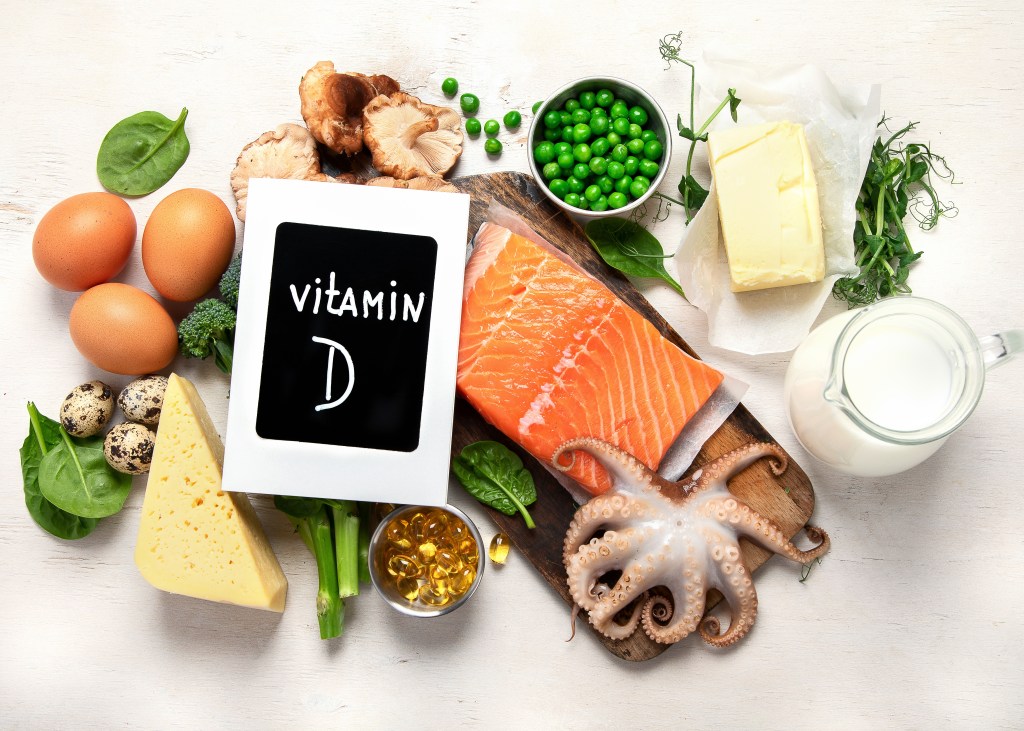At a glance
Vitamin D3 supports many essential bodily functions, including calcium balance, mood regulation, and immune activity. Because sunlight exposure, skin tone, and lifestyle factors influence how much vitamin D the body can produce, deficiency is common. Obtaining adequate amounts of D3 from the right sources can help support healthy levels over time.
Vitamin D deficiency affects almost half of all U.S. adults, leaving many at risk of poor bone health and weakened immune defenses.
Vitamin D3 is a powerful form of vitamin D that the body naturally produces when exposed to sunlight and can also be found in certain foods, particularly animal sources.
Let’s look at the profound health benefits of maintaining optimal vitamin D3 levels and learn about the best natural sources of this essential nutrient.
What is vitamin D3?
Vitamin D is produced when the skin is exposed to sunlight, which explains why it’s commonly called the sunshine vitamin.
Sunlight contains ultraviolet B (UVB) radiation that can penetrate the skin and trigger biochemical reactions that convert pre-vitamin D into active vitamin D3.
How much vitamin D is produced in response to sun exposure depends on many factors.
Older individuals and those with darker skin pigmentation may not generate enough vitamin D even if exposed to adequate sunlight. This leaves the elderly and people with darker skin tones at risk of vitamin D deficiency.
“Vitamin D3 is a fat-soluble vitamin that’s primarily stored in fat cells and the liver,” explains Dr. Berg. “While the body tends to store enough vitamin D to compensate for short periods without UVB radiation, limited sun exposure for prolonged time will lead to vitamin D insufficiency.”
Watch the video below to learn how much vitamin D you need to maintain a healthy body.
How is vitamin D3 different from vitamin D2?
Vitamin D naturally occurs as vitamin D2, also known as ergocalciferol, and vitamin D3, or cholecalciferol.
Vitamin D3 is produced in response to sunlight and can be found in a few food sources, including fatty fish, egg yolks, and beef liver. In contrast, vitamin D2 is primarily found in UVB-exposed mushrooms and yeasts.
Although vitamins D2 and D3 are structurally similar, vitamin D3 is easily absorbed, significantly more effective, and can be stored in the body for longer periods, making it the preferred form of vitamin D.
A study published in The Journal of Clinical Endocrinology and Metabolism states, “D3 is approximately 87% more potent in raising and maintaining serum vitamin D concentrations and produces a two to threefold greater storage of vitamin D than D2.”
Four health benefits of vitamin D3
Vitamin D is vital for health and regulates calcium balance, nerve signal transmission, immune defenses, and neurotransmitter production.
This fat-soluble nutrient plays such a fundamental role in various physiological functions that many scientists argue it should be classified as a hormone to emphasize vitamin D’s importance and the need to maintain optimal levels.
Here are four health benefits of vitamin D3.
1. Improves bone health
Vitamin D helps the body absorb calcium, an essential mineral necessary for developing strong bones and maintaining skeletal health.
Without adequate vitamin D levels, only a small percentage of dietary calcium can be absorbed, significantly increasing the risk of calcium deficiency and associated health problems.
Due to its role in maintaining calcium balance, vitamin D3 directly supports bone strength and contributes to proper skeletal functions.
2. Supports a strong immune system
Vitamin D3 stimulates the activity of white blood cells, including T-cells, Natural Killer cells (NK), and macrophages. These cells are the body’s primary defense against microbial infections and diseases.
Vitamin D also helps balance the ratio of immune cells, which strengthens not only immunity but also supports more balanced immune and inflammatory responses.
Research published in the Journal of Investigative Medicine highlights vitamin D’s importance for immune cell functions and underscores its role in both adaptive and innate immune responses.

3. Promotes cardiovascular health
A study published in Current Treatment Options in Cardiovascular Medicine found that individuals with low vitamin D status appeared at greater risk of cardiovascular disease.
Vitamin D is believed to help improve endothelial function, which is crucial for maintaining healthy blood vessels and optimal blood pressure regulation.
Lack of adequate vitamin D is linked to endothelial dysfunction, a condition characterized by vascular damage and a narrowing of vessels, both prime risk factors for atherosclerosis and heart disease.
4. Supports mental health
Poor mental health can develop due to a complex interplay of underlying imbalances and nutrient deficiencies, and certain vitamins may help alleviate stress and anxiety.
Vitamin D has been found to influence various areas of the brain and promote the production of serotonin, a key neurotransmitter that regulates moods.
Vitamin D deficiency has been associated with poor mood regulation, which may explain why mood disorders often develop during winter when adequate sunshine exposure is limited.

How much vitamin D3 do you need?
Vitamin D3 plays an essential role in a wide range of physiological functions, and low vitamin D levels can have serious health consequences.
Recommendations by the National Institutes of Health (NIH) suggest that adults require between 600 and 800 IU of vitamin D daily. However, this may not be enough to significantly increase blood vitamin D levels in those with severe deficiency.
In fact, research published in StatPearls found that it may require between 5000 and 10,000 IU of vitamin D3 daily to prevent deficiency, especially in individuals at increased risk of low levels.
Vitamin D requirements can vary widely depending on factors like age, overall health, medication use, lifestyle habits, and the amount of time spent in the sun, making it challenging to assess individual needs accurately.
A simple blood test from a healthcare provider can help determine vitamin D status and whether dietary or lifestyle adjustments may be needed to maintain healthy levels.

Symptoms and causes of vitamin D deficiency
Because vitamin D plays a crucial role in various essential physiological functions, low levels of this essential nutrient can lead to a wide range of health issues.
Common symptoms associated with vitamin D deficiency include:
- Muscle weakness
- Bone pain
- Frequent infections
- Skin issues
- Hair loss
- Mood changes
- Sore gums
While lack of adequate UVB exposure remains the leading cause of vitamin D deficiency, various dietary and lifestyle factors can also contribute to low levels.
These include a diet low in vitamin D-rich foods, limited outdoor activity, living in northern latitudes, and having darker skin, which reduces vitamin D synthesis.
In addition, conditions that affect digestive processes, such as celiac disease or inflammatory bowel disease (IBD), can make it difficult for the body to maintain healthy vitamin D stores without consistent sun exposure and adequate dietary intake.
Research published in The American Journal of Clinical Nutrition found a relationship between vitamin D status and body composition, meaning that those with excessive body weight often have lower circulating levels of vitamin D.
It’s believed that vitamin D, which is fat-soluble, can be sequestered in fat tissue, making it less available for use by the body. Therefore, individuals with higher body fat percentages may require more vitamin D to achieve and maintain optimal levels.

Sources of vitamin D3
The most natural way to maintain healthy vitamin D3 levels is by exposing your skin to sunlight for 10 to 30 minutes several times a week.
However, geographical locations with latitudes higher than 42° north of the equator lack adequate UVB radiation, especially during the winter months, leaving large proportions of the population at risk of insufficient vitamin D status.
This highlights the importance of consuming plenty of dietary sources of vitamin D3, such as oily fish, organ meats, and egg yolks.
While these foods typically contain only small amounts, regularly including them in your diet can contribute to maintaining healthy vitamin D levels, especially when combined with sensible sun exposure.
Key takeaways
- Vitamin D3 is crucial for bone strength, calcium balance, nerve signaling, immune activity, cardiovascular health, and mood regulation.
- Limited sunlight exposure, old age, darker skin tone, and certain medications are common contributors to vitamin D deficiency.
- Symptoms of low vitamin D may include muscle weakness, bone discomfort, impaired immune defenses, mood changes, memory problems, and hair or skin issues.
- Maintaining healthy vitamin D levels requires regular safe sun exposure, regular intake of vitamin D-rich foods, such as oily fish, egg yolks, and organ meats, and addressing factors that affect absorption or increase nutrient needs.
FAQ
1. What is vitamin D3?
Vitamin D3 is a fat-soluble vitamin produced when the skin is exposed to ultraviolet B (UVB) radiation in sunlight.
UVB rays trigger a complex cascade of biochemical reactions that convert pre-vitamin D into active vitamin D3.
2. What does vitamin D3 do for the body?
Vitamin D3 plays a vital role in regulating various physiological functions, including bone mineralization, calcium balance, cognitive processes, and immune cell activation.
3. What are the benefits of vitamin D3?
Vitamin D3 promotes healthy bones, neurotransmitter balance, strong immune defenses, and brain function.
4. How can I get vitamin D3 naturally?
Exposure to sunlight is the most natural way to get vitamin D3.
However, individuals who are overweight, have a darker skin tone or live at latitudes greater than 42° north of the equator may not produce adequate vitamin D3 from sunlight, leaving them at an increased risk of deficiency.
5. How much vitamin D3 do I need daily?
How much vitamin D3 you need to maintain healthy levels depends on your vitamin D levels, sunlight exposure, health status, and skin tone.
Most healthcare providers suggest that the body requires between 600 and 800 IU of vitamin D daily to maintain optimal levels. However, correcting a severe vitamin D deficiency may require significantly more vitamin D.
6. What are the symptoms of vitamin D3 deficiency?
Symptoms of vitamin D3 deficiency include bone pain, low immune defenses, hair loss, muscle weakness, memory problems, acne, and depression.
7. What causes vitamin D3 deficiency?
Lack of adequate UVB radiation is the most common cause of vitamin D3 deficiency. In addition, those with a darker skin tone and the elderly tend to produce less vitamin D, leaving them at risk of deficiency despite adequate sunlight exposure.
There also is evidence that certain medications, such as laxatives, corticosteroids, and weight-loss drugs, can impair intestinal vitamin D absorption linked to deficiency.
8. Can you get vitamin D3 from food?
Yes, you can obtain vitamin D3 from dietary sources such as oily fish, egg yolks, and organ meats.
However, these foods provide relatively small amounts, making it difficult to maintain healthy vitamin D levels through diet alone, especially without sufficient exposure to sunlight.
9. What are the symptoms of vitamin D3 toxicity?
Common symptoms of vitamin D3 toxicity include vomiting, nausea, muscle pain, confusion, unexplained weight loss, and elevated blood calcium levels.
It’s important to note that vitamin D toxicity isn’t caused by dietary intake or sunlight exposure and almost exclusively results from excessive vitamin D supplementation.
10. Does vitamin D3 interact with medications?
No, vitamin D3 obtained from food sources or sunlight exposure isn’t known to cause interactions with medications.
However, individuals with poor liver function or kidney disease may have altered vitamin D metabolism, which can influence overall status.
Sources
- https://academic.oup.com/jcem/article/96/3/E447/2597204
- https://pmc.ncbi.nlm.nih.gov/articles/PMC3166406/
- https://pmc.ncbi.nlm.nih.gov/articles/PMC3449318/
- https://ods.od.nih.gov/factsheets/VitaminD-HealthProfessional/
- https://www.ncbi.nlm.nih.gov/books/NBK532266/
- https://pmc.ncbi.nlm.nih.gov/articles/PMC2728638/


















